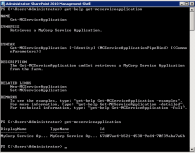In this post, we look at leveraging T4 templates to extend the power of LLBLGen inside of Visual Studio .NET. Writing T4 templates to auto-generate code is almost a norm at this point it seems, it’s built-in to ASP.NET MVC, and used as a first-class tool in most ORMs. So why not use T4 templates to extend the power of LLBLGen as well.
Theming ServiceStack Razor Views

In this post, we look at adding theming capabilities to the ServiceStack Razor View engine. Source and live demo are included. This post is third in a series investigating ways to leverage ServiceStack in building a RESTful API and UI from a database. The main objective for this new theming capability is to allow easy development of new themes on top of the ServiceStack Razor view engine, with fallback capability to the default theme for views, content pages, master pages and layouts that don’t require specific theming.
.net, C#, llblgen, rest, servicestackRESTful Api and UI for Typed Views and Typed Lists with LLBLGen and ServiceStack

In this post, we extend the implementation described in the prior post to include generating an HTML UI and RESTful Api on top of LLBLGen Typed Views and Typed Lists, leveraging the ServiceStack web service and razor framework. The api provides paging, sorting, filtering – source is hosted on GitHub, and a demo is included as well.
code generation, llblgen, odata, orm, rest, servicestackGenerating a fully RESTful Api and UI from a database with LLBLGen and ServiceStack (templates on Github and Demo)

Service-based data adapter for LLBLGen entities using ServiceStack

SimpleMembershipProvider in MVC4 for MySql, Oracle, and more with LLBLGen

SharePoint 2010 Service Application Development 101 – MailChimp Integration Example

In this post, we will leverage the custom service application infrastructure and solution we put together in the last 4 posts to enhance the service application with new features and capabilities. The sample feature we will add is an integration between SharePoint and MailChimp, enabling sites to synchronize a contacts list to a MailChimp list.
.net, C#, MailChimp, mycorp, saf, service application, sharepoint, wcfSharePoint 2010 Service Application Development 101 – Admin UI and PowerShell

In this post we explore how to configure various aspects of a SharePoint 2010 service application. This includes building some customizations in the application pages and extending the service application with powershell scripts. It is really up to your imagination when it comes to what you want to include and how you want to manage your service app, SharePoint gives you a tremendous amount of flexibility when it comes to these things.
.net, admin, C#, mycorp, powershell, sharepointSharePoint 2010 Service Application Development 101 – Base Solution

In this post, we are going to explore the guts of our custom service application, expect lots of code in this post. As I mentioned in my first post in this series, the goal of this Service Application development exercise is to build an infrastructure within SharePoint 2010 for your company to add value to your SharePoint investment, by exposing 3rd party and custom capabilities and features to your farm(s) in a scalable and maintainable way.
C#, isv, mycorp, saf, service application, sharepointSharePoint 2010 Service Application Development 101 – Logical Components

In this post we explore the essential components that make up a service application and the relationships between them: servers, services, service proxies, service instances, service applications, service application proxies, and load-balancers. In addition to these core components, we will also explore adding job definitions and databases to the mix.
load balancing, mycorp, saf, service application, sharepoint
